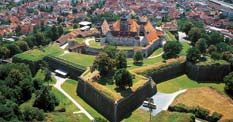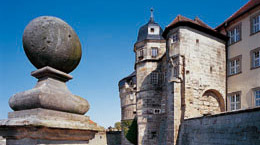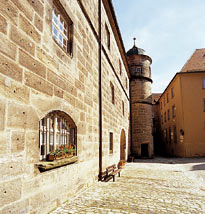|
|
 |
 |
 |
|
 Kronach Kronach
Rosenberg Fortress |
|
High above the old town centre of Kronach rises the Rosenberg fortress. With an area of 23.6 hectares it is considered to be the largest fortification in Germany. The almost completely symmetrical fortress complex has developed over the centuries, surrounded even today by a complex of walls, moats, buildings, and gates. The various stages of building are clearly recognizable – the medieval keep and the 15th and 16th century towers as well as the pentagonal late baroque bastion – reflecting the new challenges that had to be met in the construction of defensive bulwarks throughout the ages.
|
|
 |
|
|
|
 |
|
The Franconian Gallery in the Rosenberg fortress, a branch museum of the Bavarian National Museum, displays Franconian works of art from the Middle Ages and the Renaissance in 25 showrooms. Prestigious names can be found there: Lucas Cranach the Elder, Kronach's most famous son, is represented by several paintings; a series of previously unknown sculptures by Tilman Riemenschneider and his workshop are on exhibition. Especially notable are the paintings by Wolfgang Katzheimer the Elder and the Bamberg school of painting from around 1500 as well as those by Hans von Kulmbach, a student of Duerer.
The heritage of the old masters is complemented by regular special exhibitions covering the most diverse areas of art in the newly renovated rooms of the fortress. |
|
|
|
|
|

|
|
|
|
Local History of Kronach |
|
In the year 1003 the city Kronach is first proved by documents.
In 1122 Kronach area passed into possession of the collegiate monastery of Bamberg. Until 1803 the bishops were the sovereigns of Kronach.
In the 13th century the city of Kronach received municipal law.
In 1430 Kronach was besieged. To defend the city the people of Kronach living in the upper town set the houses of the suburbs on fire.
During Thirty Years’ War Kronach was attacked and besieged by the Swedish troops (1632, 1633 and 1634).
In 1806 the French Emperor Napoleon Bonaparte stayed in Kronach. From here he ordered his army to attack Prussia. |
|







